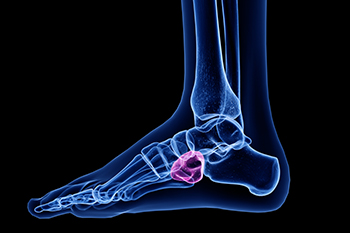

There are seven tarsal bones in each foot, and the cuboid bone is one of them. An injury can cause pain on the outside of the foot when the cuboid bone is affected, which can result in cuboid syndrome. Some patients feel pain in the middle of their foot, or on the bottom of the fourth and fifth toes. This condition can occur when the bones in the center of the foot become partially dislocated from gradual overuse, or from a sudden injury. It is a common injury among ballet dancers, as a result of this style of dancing. Patients who have feet that turn inward may have an increased risk of developing cuboid syndrome, in addition to wearing shoes that do not fit correctly. People who run on uneven surfaces may get this condition, and warming up or cooling down inadequately may increase the risk of having cuboid syndrome. Effective treatment begins with temporarily stopping the activity that caused the condition, and frequently elevating the affected foot may reduce the swelling. If you have this ailment, please consult with a podiatrist who can accurately diagnose and treat cuboid syndrome.
Cuboid syndrome, also known as cuboid subluxation, occurs when the joints and ligaments near the cuboid bone in the foot become torn. If you have cuboid syndrome, consult with Massimo Pietrantoni, DPM from Rochester Podiatry, LLP. Our doctor will assess your condition and provide you with quality foot and ankle treatment.
Cuboid syndrome is a common cause of lateral foot pain, which is pain on the outside of the foot. The condition may happen suddenly due to an ankle sprain, or it may develop slowly overtime from repetitive tension through the bone and surrounding structures.
Causes
The most common causes of cuboid syndrome include:
Symptoms
A common symptom of cuboid syndrome is pain along the outside of the foot which can be felt in the ankle and toes. This pain may create walking difficulties and may cause those with the condition to walk with a limp.
Diagnosis
Diagnosis of cuboid syndrome is often difficult, and it is often misdiagnosed. X-rays, MRIs and CT scans often fail to properly show the cuboid subluxation. Although there isn’t a specific test used to diagnose cuboid syndrome, your podiatrist will usually check if pain is felt while pressing firmly on the cuboid bone of your foot.
Treatment
Just as the range of causes varies widely, so do treatments. Some more common treatments are ice therapy, rest, exercise, taping, and orthotics.
If you have any questions, please feel free to contact one of our offices located in Brighton and Greece of Rochester, NY . We offer the newest diagnostic and treatment technologies for all your foot care needs.